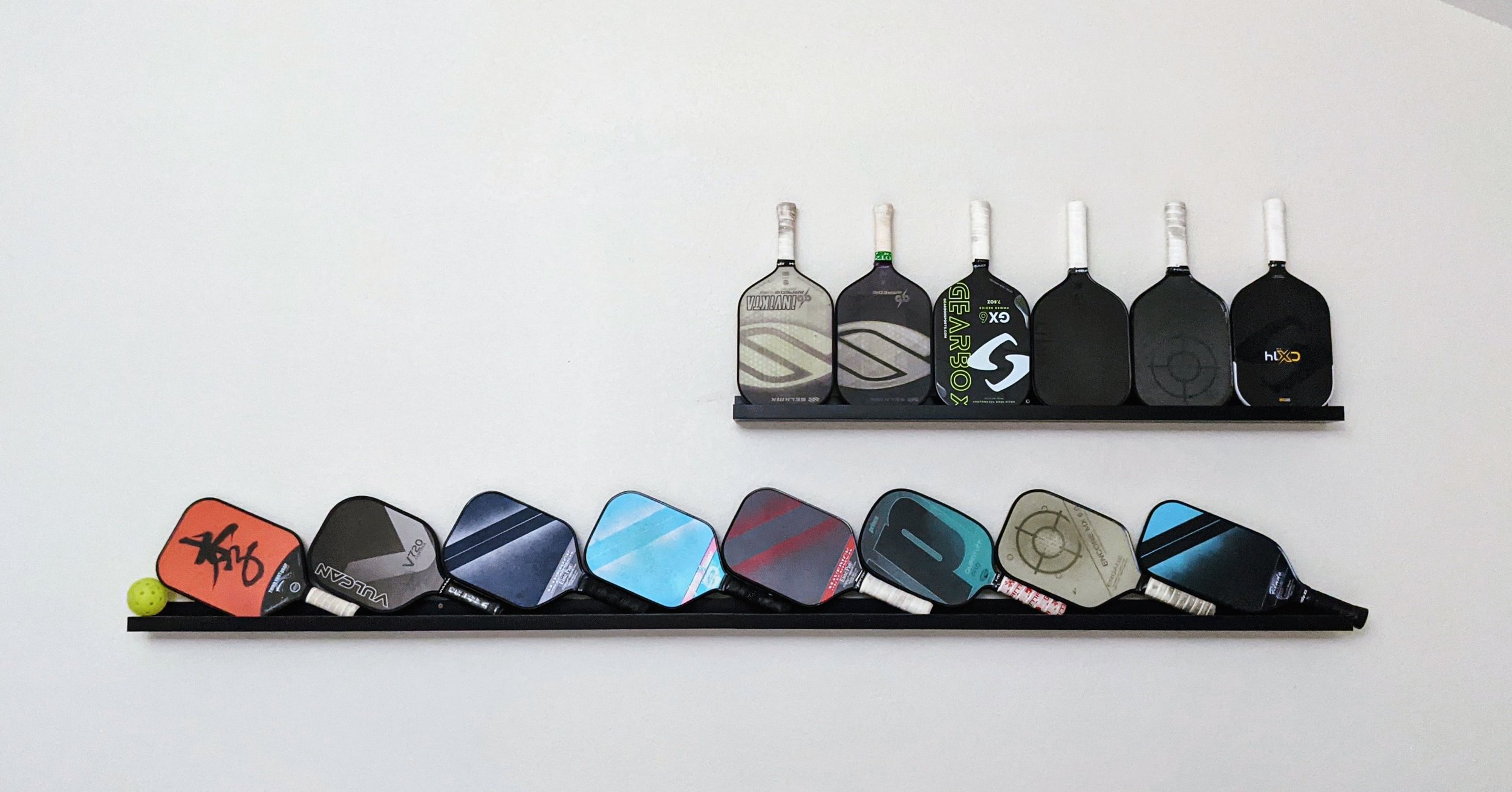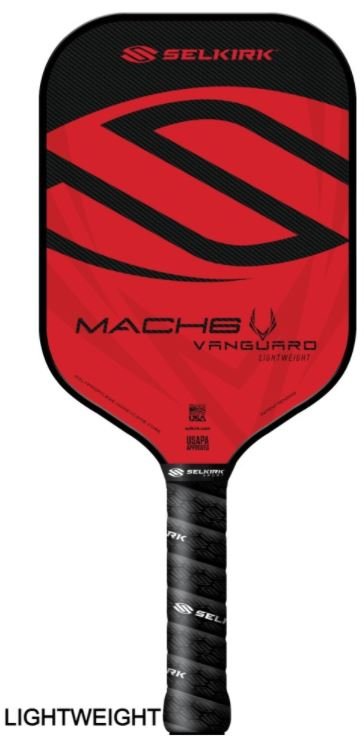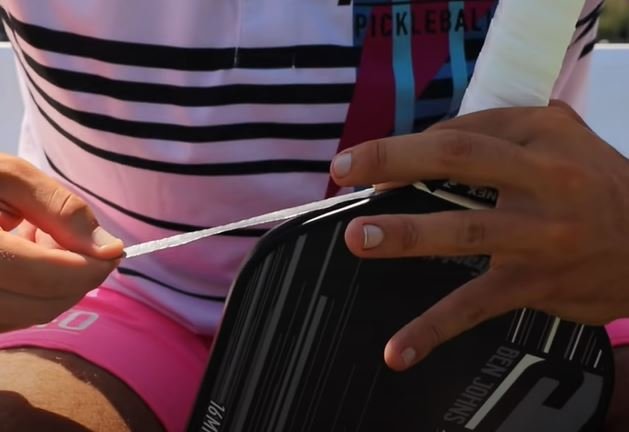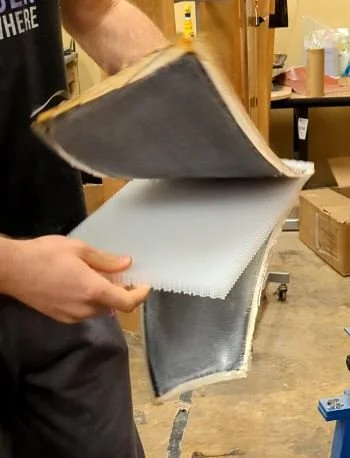7 Things to Look For in a Pickleball Paddle
So you’ve been playing a while and think you want to upgrade to a new paddle. How do you begin your search? Your Instagram feed is inundated with old and new brands throwing out marketing gibberish and flashy ads for their latest and greatest paddles. You want to try some, but don’t know how to narrow it down. Also, why is a pickleball paddle $200??
We’ve been in your shoes before. There will never be a perfect guide that tells you exactly what paddle to buy — you just need to try them and make a choice. This guide is meant to give you a framework to help narrow your list down from the 1,200 paddles out there. Throughout the guide, we’ve linked some good resources, like videos and demo programs, and we will continually update this guide as companies innovate. As your pickleball game evolves, your needs from a paddle may change, so bookmark this link to refer to when that happens.
The paddle journey continues for Byron (@byronandcats on IG)
There are 7 main characteristics that make up a paddle: thickness, core material, handle length, paddle shape, weight, surface material, and price and warranty. USAP guidelines state that paddles’ combined length and width may not be longer than 24 inches and paddle length cannot exceed 17 inches. This is why there are some tradeoffs between the different characteristics.
Thickness
Paddles are typically between 11mm and 16mm thick. The thinner the paddle, the more “pop” you’ll get off the surface. The thicker a paddle, the more it will absorb the ball’s energy. If a paddle comes in 13mm and 16mm thicknesses, 13mm will be the “power” and 16mm will be “control”. Some brands like Gearbox, Prokennex, and Diadem only have one thickness per paddle.
It may not seem like much but 3MM can make a big difference
Core Material
You have 3 types of main cores: Wood, Nomex, and Polycore. Ignoring the wood paddles some of us played with in high school, Nomex is the first composite core that was used in a pickleball paddle. The (in)famous Onix Z5 uses Nomex, and that is what gives it its notorious power and pop sound. The power you get from a Nomex paddle comes at a pretty large sacrifice to “touch” or “control”. Most pros are playing with some sort of polycore paddle. Polycore plastic (PP) is a plastic honeycomb sandwiched between some layers of “proprietary” materials. There are brands like Prokennex and Gearbox that have created a proprietary core material that is unlike the rest of the brands, so the feeling of hitting with them is very unique.
Make your own paddle on Alibaba…
Handle Length and Shape
Depending on your grip and racket sport background, you may prefer a different handle length and shape. If you come from ping pong and use a ping pong like handshake grip, you probably don’t need a long handle as you will be choking up on the paddle. If you like to incorporate a two handed backhand, then the standard sub 5” long handles won’t be enough so look for something 5.25”+. Also, some handles have more rounded edges, while others have the more traditional octagonal tennis grip shape. Be careful, some manufacturers have rounded handles but put an octagonal buttcap on a handle, so looks can be deceiving.
Screen grabbed from Chris Olson @The Pickleball Studio’s recent review of CBRN, Engage Pursuit, and Electrum paddles
A subcategory of the handle is the grip size. Too small of a grip and your hand will get tired and you’ll often grip the paddle too tightly which will create pop ups and can lead to tennis elbow. If it is too big, you will lose maneuverability and it requires extra effort as well. There are a few ways to determine the grip size you should go with, but always err on the side of smaller. You can always add an over grip if it turns out to be too small.
The following is directly from pickleballcentral
1. Height test
This informal test is supposed to work for both men and women. It's simple and works for the people we've tested. Remember, if in doubt, go with a smaller grip.
Height...........Grip Size
Under 5'2".......4 inch grip
5'3" to 5'8".....4 1/4 inch grip
5'9" & taller...4 1/2 inch grip
2. Finger test
Hold your dominant palm up. Notice your palm has three major creases. Take a ruler and measure from the middle crease of your palm, up to the tip of your ring finger. This measurement should reflect the perfect grip size for you. If you are unsure between two sizes, choose the smaller size.
3. Printable grip-sizer chart
Here's an easy, print-out chart we designed to simplify the task of determining your grip size. Print it out and determine your approximate grip size.”
Paddle Shape
The more traditional squarer paddles provide a more forgiving sweet spot. Anything elongated will give you extra power because of the additional leverage from the length, at the cost of a smaller sweet spot. Some say elongated paddles are for more “advanced” players because of that sacrificed sweet spot. Many brands have a normal and elongated version of the same paddle, but some like Onix and Diadem don’t.
Elongated vs Standard
Weight
Paddles can be anywhere between 7.2oz all the way up to 8.3oz. There is usually a .3oz range when you order a new paddle. Obviously the lighter the paddle, the more maneuverable it will be and the less power you’ll get. You’ll see videos of some pros taking standard paddles, and then adding weighted tape (lead or tungsten) to different areas of the paddle. More weight in the throat gives more stabilization without sacrificing hand speed. More weight at the tip of the paddle provides more power. Some pros are even making their paddles up into the 10oz range, but be wary about the strain on your wrist and hands with the extra weight.
Ben Johns adding lead tape to the throat for more stabilization while limiting the effect on hand speed
Surface material
The surface is what determines how much spin a paddle can produce. The USAPA uses a friction measuring device to make sure the paddle is below a certain friction coefficient, but paddle manufacturers are always coming up with new ways to push their surfaces to the edge. Some paddles like the Ben John’s Signature paddle uses a spray on sandpaper essentially, and that is why the grit eventually wears off. More and more manufacturers are now using a graphite or carbon fiber as their surface so that friction is built in. Our friend Chris Olson over at The Pickleball Studio has done a lot of work on testing spin across several different paddles. For the data, here’s his spreadsheet of all the RPMs he gets from each paddle.
Layers of carbon fiber, fiber glass, and plastics about to be pressed onto a polycore
Price and Warranty
You have three tiers of paddle pricing: $50-$100, $100-$150, and $150+. Some paddle brands at the top of the range like Engage and Selkirk have lifetime warranties. I have only had or heard good experiences with their customer service, and they replaced paddles when they had issues with the surface, edge guard or handle. Some of the less expensive paddles have shorter, limited warranties between 90 and 120 days. To do the math - a Franklin Ben John’s has a 90 day warranty, so if you buy two and go through them in 8 months, that’s the same as getting one Engage or Selkirk that could be replaced indefinitely. Shea Underwood has a great video on the paddles pros use and their retail costs. Also remember you can almost always find 20-25% discount codes off retail price, and some companies sell blemished paddles at a discount. Just need to know who to ask ;)
TLDR:
Thin = power, thick = control
Core = Poly is standard, Gearbox and Prokennex have proprietary cores, you have to try to get a feel for it
Longer Handle = two handed backhand. Play with a ping pong grip = shorter handle. Tennis players love octagon handles. Get the right grip size!
Elongated = more power, smaller sweet spot
Heavier = more power but slower hands. Can start lighter and add weighted tape if you want.
Carbon face has the most grit for max spin.
Weigh the price and the warranty against each other. Find discount codes or blemishes.
Where to purchase paddles
We are lucky enough to partner with JustPaddles.com to bring you the best selection of paddles and a 5% discount code on almost anything you buy. When you purchase through the link above, you’re also helping to support us through a referral bonus, so thank you!
Don’t go chasing paddle drops
My last piece of advice is don’t go chasing every new paddle that hits the market. If you are a 3.5 player, it is tempting to think that a new paddle with the latest technology will suddenly bring you up to 4.0, but honestly the only way to do that is by drilling and studying your game. We will cover that topic sometime in the future, but until then good luck on your paddle search, and if you have any questions, let us know!











